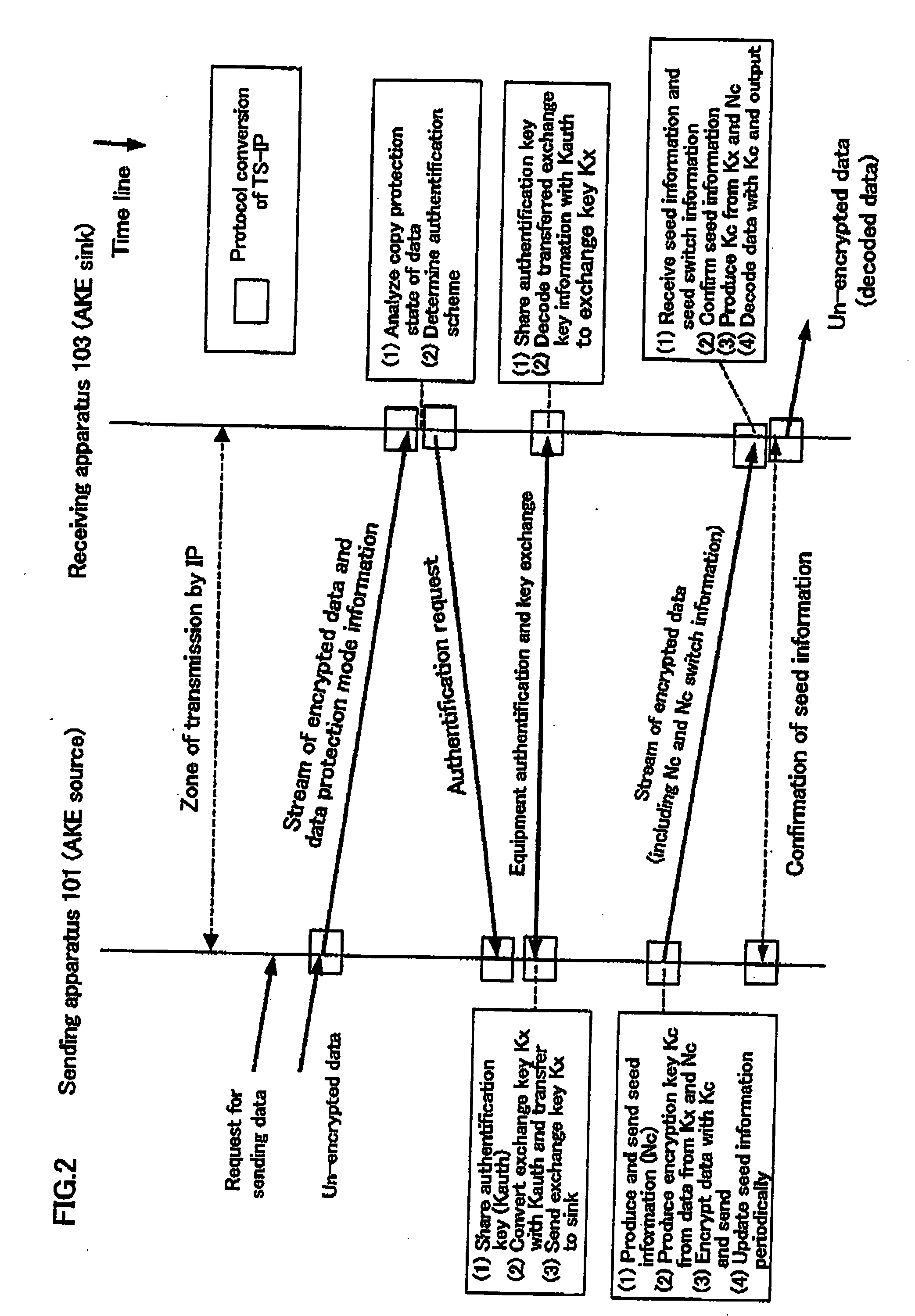Packet transmission/reception device
a packet transmission and receiver technology, applied in the field of packet transmission/reception devices, can solve the problems of not being known until, implementing the dtcp scheme on an ip protocol, etc., and achieve the effects of preventing data eavesdropping, high security, and simple structure of the sending/receiving apparatus
- Summary
- Abstract
- Description
- Claims
- Application Information
AI Technical Summary
Benefits of technology
Problems solved by technology
Method used
Image
Examples
embodiment 1
[0157]FIG. 4 is a block diagram of a packets sending / receiving apparatus 401 according to Embodiment 1 of the present invention.
[0158] The packets sending / receiving apparatus 401 performs authentification and key exchange which conform to the DTCP scheme to send and receive packets. In this example, it is assumed that the packets sending / receiving apparatus 401 send packets to another packet sending / receiving apparatus having similar functions as the packets sending / receiving apparatus 401 and receives packets from such packets sending / receiving apparatus. Thus, the packets sending / receiving apparatus 401 sends sending packets to the destination of the sending packets and receives reception packets from the source of the reception packets.
[0159] The packets sending / receiving apparatus 401 includes: authentification / key exchange means (hereinafter, also referred to as AKE means) 402 for producing an encryption key and a decoding key; encryption means 406 for producing encrypted sen...
embodiment 2
[0241]FIG. 7 is a block diagram of a packets sending / receiving apparatus 401A according to Embodiment 2 of the present invention.
[0242] The packets sending / receiving apparatus 401A has a similar structure as the packets sending / receiving apparatus 401 described with reference to FIG. 4 in Embodiment 1 except for that it further includes sending queue control means 601, first queue means 602, and second queue means 603. In the following description, the sending queue control means 601, the first queue means 602 and the second queue means 603 will be mainly described in order to simplify the description.
[0243] The packetization means 403 performs a TCP / IP protocol process to general data to produce first packets group, and outputs the first packet group to the first queue means 602. In this example, general data is, for example, sending condition setting information or AKE related information.
[0244] The first queue means 602 temporarily stores the first packets.
[0245] The packetiz...
embodiment 3
[0261] Embodiment 3 will be described.
[0262]FIG. 8 is a block diagram of a packets sending / receiving apparatus 401B according to Embodiment 3 of the present invention.
[0263] The packets sending / receiving apparatus 401B has a similar structure as the packets sending / receiving apparatus 401A described with reference to FIG. 7 in Embodiment 2 except for that the packetization means 403 includes first packetization means 701 and second packetization means 702, and the packets reception means 405 includes a first packets reception means 703 and second packets reception means 704. In the following description, the first packetization means 701, second packetization means 702, the first packets reception means 703 and the second packets reception means 704 will be mainly described in order to simplify the description.
[0264] First, how the receiving / sending apparatus 401B send a sending frame will be described.
[0265] The first packetization means 701 includes a processor, for example. T...
PUM
 Login to View More
Login to View More Abstract
Description
Claims
Application Information
 Login to View More
Login to View More - R&D
- Intellectual Property
- Life Sciences
- Materials
- Tech Scout
- Unparalleled Data Quality
- Higher Quality Content
- 60% Fewer Hallucinations
Browse by: Latest US Patents, China's latest patents, Technical Efficacy Thesaurus, Application Domain, Technology Topic, Popular Technical Reports.
© 2025 PatSnap. All rights reserved.Legal|Privacy policy|Modern Slavery Act Transparency Statement|Sitemap|About US| Contact US: help@patsnap.com



